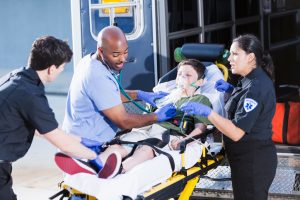
Should I volunteer as an emergency medical technician (EMT) or a medical scribe? That was the question I faced during my sophomore year as I started to think about adding clinical experience to my medical school application.
How I chose my clinical experience
Of course, there are many other opportunities for gaining clinical experience apart from being an EMT or scribing—but ultimately I wanted to do something that would help me stand out as an applicant.
So, I visited a fire station to “ride along” and shadow the ambulance crew for half a day. After the ride along, I better understood the job of EMS/fire rescue personnel and the skills needed to interact with patients. Soon thereafter, I joined my local fire station. After taking a six-week (165-hour) summer course and passing the Maryland practical exam and the NREMT exam, I got certified as an EMT.
While on shift as an EMT
At my station, career and volunteer fire and emergency medical services (EMS) personnel work togetherduring shifts. With all sorts of stories and teaching moments from our seasoned crew, our workplace stays exciting and productive. As a volunteer, I am assigned to one night a week and thus dedicate my Friday nights for my EMT shift from 5 p.m. to 7 a.m.
When I started as a new EMT at my station, I shadowed charge EMTs (more experienced EMTs) to learn how they conduct calls. Once I was ready, I devoted several months to practicing skills and protocols to become a charge EMT. Now, as a charge EMT, I am leading my own ambulance crew and taking on bigger responsibilities.
Facing a huge learning curve
Taking the EMT course does not completely prepare you for facing real situations and dealing with unexpected challenges. Even if I learned about treatments to alleviate signs and symptoms of a particular condition, I need to first talk with patients to understand their full history before I administer treatment. In addition to refining my assessment and communication skills, I’ve learned how to manage myself, my crew, and patients on a wide variety of calls. I’ve soothed concerned parents and shocked passengers involved in car accidents. I’ve encountered numerous overdoses, heart attacks, and broken bones.
Most of all, I’ve learned an incredible amount from watching the more experienced volunteers conduct calls, as well as by conducting calls as a leader with my crew. I’ve also discovered a lot about myself in the face of stressful conditions (whether it’s the nature of the call or the expectations of your fellow shift members). Being an EMT doesn’t just test how well you can take care of the patient and family; it also tests your knowledge of protocols and your abilities to multitask and lead. I am really happy I chose to become an EMT because it has greatly contributed to who I am today.
What about ER Scribing for clinical experience?
One of my best friends is also applying to medical school. She is a scribe for a DC hospital. Her training consisted of a medical terminology session, a course on hospital charting (six classroom sessions, three hours each), and several opportunities to shadow the experienced scribes. Shifts are 7 a.m.—3 p.m., 11 a.m.—9 p.m., 9 p.m.—7 a.m., or some other slight variation of those times.
She works closely with the ER physician on her shift and gets a pretty good idea of how her doctor interacts with patients to assess and appropriately treat. However, the amount of patient interaction is minimal since the doctor, PA, nurse, or tech is verbally and physically interacting with the patient. A scribe is present in the patient’s room but is only responsible for recording these interactions rather than making decisions or conducting assessment and treatment.
Questions I’m often asked about being a volunteer EMT
Q: How do you stay up for your 10-hour shift?
A: We can sleep at our normal bedtime hours, but when the tones go off, we wake up to respond. As a scribe or EMT, you have to be able to wake up at any time.
Q: What’s the coolest thing you’ve done?
A: I’ve gotten to work with a flight paramedic to package a patient after a really bad car accident to transport to Shock Trauma Center in Baltimore. Seeing that helicopter was pretty cool!
Q: How many calls do you get per night?
It depends on the night. A really busy night is about 6 calls. The duration of a call ranges from 10 minutes to an hour. The entire process of a call starts from being on scene to assessing the patient(s), transporting to the hospital, interacting with the medical staff, and writing a completed report for the hospital.
Complement your clinical experience by adding a winning MCAT score to your medical school application. Register for our free Inside the Classroom events to preview a prep course.

